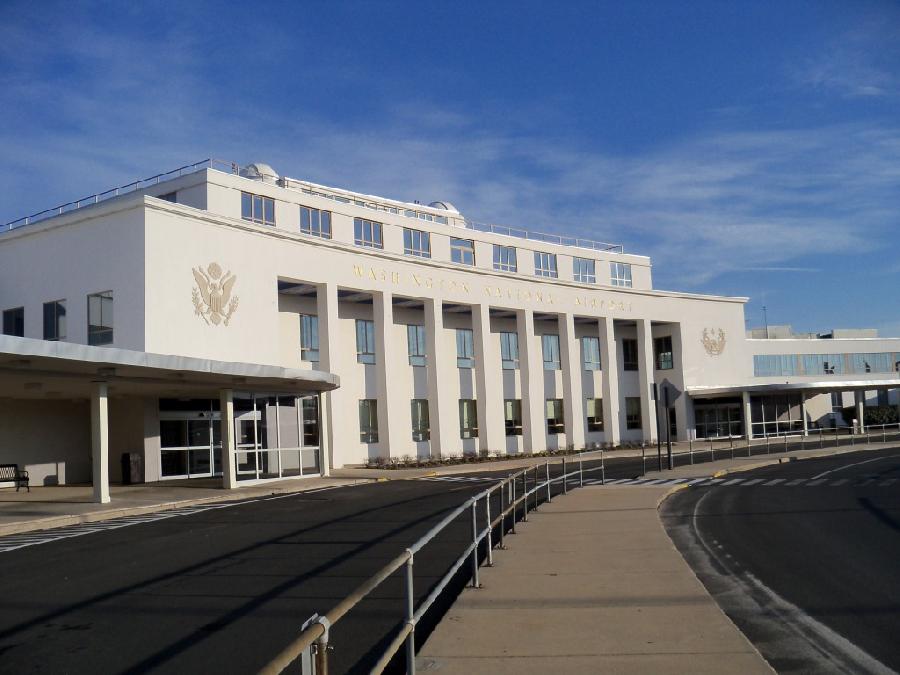- City:
- Arlington, VA
- Site Type:
- Infrastructure and Utilities, Airports
- New Deal Agencies:
- Civil Aeronautics Board (CAB), Conservation and Public Lands, Federal & Military Operations, Public Works Funding, Work Relief Programs, National Park Service (NPS), Army Corps of Engineers, Public Works Administration (PWA), Works Progress Administration (WPA)
- Started:
- 1938
- Completed:
- 1941
- Contractor:
- John McShain Builders
- Quality of Information:
- Very Good
- Marked:
- Yes
- Site Survival:
- Extant
Description
The first Washington DC airport was built during the New Deal. Long known as National Airport, it was renamed for former President Ronald Reagan in 1998. Most locals still refer to it by its former name.
Construction began in 1938, after “President Franklin D. Roosevelt announced at a press conference that he was ‘tired of waiting for Congress’ to select a site for the new airport and said that it would be built on mudflats on a bend of the Potomac River at Gravelly Point, 4 miles south of the District of Columbia.” (Airport Authority website)
Several federal agencies were involved in the creation of National Airport. The newly-formed Civil Aeronautics Board (predecessor to the Federal Aviation Administration) was in charge, but funding and labor came principally from the Public Works Administration (PWA) and Works Progress Administration (WPA). The Army Corps of Engineers, the National Park Service and the Fine Arts Commission also participated.
The original terminal building, now called Terminal A, was constructed by a private firm, John McShain Builders. It is a beautiful, curving Moderne-style building.
The airport opened for business in June 1941 and President Roosevelt attended the opening ceremony. It is likely that work continued on the site for some time thereafter.
The Index to WPA Projects in the National Archives describes WPA work on the site in 1941: “Construct airport facilities…completing the construction of hangars, buildings, and other structures and facilities; constructing runways, aprons, taxi strips, roads, walks, parking areas and lightning and air navigation facilities; filling, grading and draining; landscaping; incidental and appurtenant work.”
According to the Washington Post, this work employed 2,837 workers with a budget of $5,503,000, and it included a landing field for Pan American Airways.
Ironically, Ronald Reagan’s father was a WPA worker during the Great Depression, saving the family of the future president from destitution. As a young man, Reagan was a Democrat, but his views changed during the Cold War era.
Source notes
History of Ronald Reagan Washington National Airport, Metropolitan Washington Airports Authority website
National Archives, Record Group 69, “Microfilmed Index to WPA Projects.”
“Army of 3,690 from WPA starts strengthening Capital defenses,” Washington Post, July 11, 1940, p. 5
Carl Brauer, The Man Who Built Washington: A Life of John McShain. Wilmington DE: Hagley Museum and Library, 1996
"Ronald Reagan and the WPA," WPAToday.org
Site originally submitted by Brent McKee on May 11, 2012.
Additional contributions by Richard A Walker.
At this Location:
Contribute to this Site
We welcome contributions of additional information on any New Deal site.
Submit More Information or Photographs for this New Deal Site












This site is a good website to go on
I’m with the Arlington Historical Society in Arlington, VA. We have a question about a window in the original terminal that we have a photo of. It is an etching of a stylized eagle (perhaps in the art deco style). Eagles on New Deal buildings are not uncommon, but I’d like to send you the photo to ask you if this window would have signified that the airport was a new deal building or if it’s just a stylized eagle. Thank you for this site. Annette Benbow (on behalf of the Arlington Historical Society)